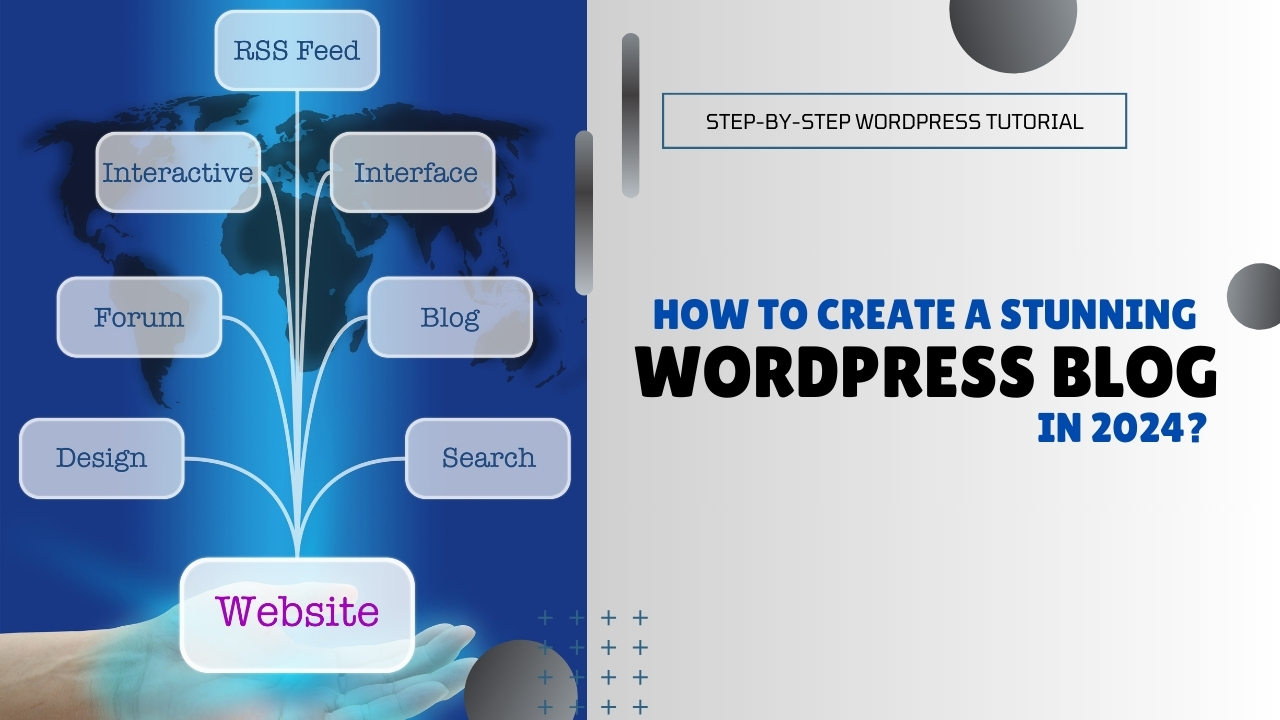Creating a stunning WordPress blog in 2024 involves a mix of creativity, technical skills, and an understanding of the latest trends and tools. With the right approach, you can craft a blog that stands out and attracts readers. Here’s a comprehensive guide to help you create a stunning WordPress blog in 2024.
Why Choose WordPress for Your Blog?
WordPress remains the most popular blogging platform for several reasons. It’s versatile, user-friendly, and highly customizable, making it an ideal choice for both beginners and experienced bloggers. One of the main advantages of WordPress is its extensive library of themes and plugins, allowing you to create a unique and functional blog without needing to code from scratch. Additionally, WordPress is SEO-friendly, which helps in optimizing your blog to rank higher in search engine results.
WordPress powers over 40% of all websites on the internet, a testament to its reliability and performance. The platform is open-source, meaning it’s continuously updated and improved by a large community of developers. This ensures you have access to the latest features and security updates, keeping your blog secure and up-to-date.
Moreover, WordPress offers a range of hosting options, from shared hosting to dedicated servers, allowing you to choose the best plan according to your needs and budget. The flexibility of WordPress makes it a scalable solution, capable of growing with your blog as your audience expands.
Setting Up Your WordPress Blog

Setting up a WordPress blog in 2024 is straightforward, but it’s essential to follow a structured approach to ensure everything runs smoothly. Here’s a step-by-step guide:
- Choose a Domain Name and Hosting Provider: Your domain name should reflect your blog’s niche and be easy to remember. Hosting providers like Bluehost, SiteGround, and WP Engine offer excellent WordPress hosting services.
- Install WordPress: Most hosting providers offer one-click WordPress installation, making it easy for you to get started.
- Configure Settings: After installation, configure your WordPress settings, including permalinks, time zone, and reading settings.
- Select a Theme: Choose a theme that aligns with your blog’s niche and aesthetic preferences.
- Install Essential Plugins: Plugins add functionality to your blog. Start with essential plugins for SEO, security, and performance.
- Create Key Pages: Develop essential pages like About, Contact, and Privacy Policy.
- Start Blogging: Begin creating content and publishing posts.
By following these steps, you ensure your blog is set up correctly, optimized for performance, and ready to attract readers from day one.
Also Read:
- VapourHost Review (August 2024): Unveiling the Pros and Cons of VapourHost
- Sitecountry Hosting Review: A Review of Features, Performance, and Customer Support
- Nestify Hosting Review (August 2024): The Pros, The Cons, and My Personal Experience
- Verpex Hosting Review (August 2024): Unveiling the Pros and Cons of Verpex Hosting In-Depth Review
- MilesWeb Hosting Review (August 2024): Our Experience with Their Hosting Services
- GreenGeeks Hosting Review (August 2024): Is It Worth the Hype? Our Honest Review
Choosing the Perfect Theme
Selecting the right theme is crucial for the success of your WordPress blog. Your theme determines your blog’s appearance and user experience, so it’s essential to choose one that complements your content and brand. In 2024, the trend is towards minimalist, responsive, and SEO-friendly themes. Here are some tips to help you choose the perfect theme:
- Simplicity: Opt for a simple and clean design that makes your content stand out.
- Responsiveness: Ensure the theme is mobile-friendly, as a significant portion of your audience will access your blog from mobile devices.
- SEO-Friendly: Look for themes optimized for search engines. Features like fast loading times, clean code, and proper HTML structure can boost your SEO efforts.
- Customization Options: Choose a theme that offers customization options without requiring coding skills. This allows you to tailor the design to fit your brand.
- Support and Updates: Select a theme from a reputable developer who provides regular updates and reliable support.
Popular themes in 2024 include Astra, GeneratePress, and Divi, which offer a balance of aesthetics, functionality, and performance.
Essential Plugins for Enhancing Your Blog
Plugins are powerful tools that enhance the functionality of your WordPress blog. With thousands of plugins available, it can be challenging to choose the right ones. Here are some essential plugins to consider:
- Yoast SEO: This plugin helps optimize your blog for search engines by offering suggestions for improving your content’s SEO.
- Jetpack: A comprehensive plugin that offers security, performance, and marketing tools.
- Akismet Anti-Spam: Protects your blog from spam comments.
- WP Rocket: A caching plugin that improves your blog’s loading speed.
- Elementor: A page builder that allows you to create custom layouts without coding.
- MonsterInsights: Integrates Google Analytics with your WordPress blog, providing insights into your audience’s behavior.
- UpdraftPlus: A backup plugin that ensures your blog’s data is safe.
By installing these plugins, you enhance your blog’s functionality, security, and performance, providing a better experience for your readers.
Crafting Compelling Content

Content is king in the blogging world. Creating compelling content that resonates with your audience is crucial for the success of your WordPress blog. Here are some tips to help you craft engaging content:
- Understand Your Audience: Research your target audience to understand their interests, pain points, and preferences. This allows you to create content that addresses their needs.
- Create a Content Calendar: Plan your content in advance to ensure consistency. A content calendar helps you organize your ideas and schedule posts.
- Write Catchy Headlines: Your headlines should grab the reader’s attention and encourage them to click through to your content.
- Focus on Quality: Ensure your content is well-researched, informative, and valuable. Avoid fluff and provide actionable insights.
- Use Visuals: Incorporate images, videos, infographics, and other visuals to make your content more engaging.
- Optimize for SEO: Use keywords strategically, include meta descriptions, and ensure your content is optimized for search engines.
- Engage with Your Readers: Encourage comments, ask questions, and interact with your readers to build a community around your blog.
By focusing on these aspects, you can create content that attracts and retains readers, driving traffic to your blog.
SEO Best Practices in 2024

SEO is essential for driving organic traffic to your WordPress blog. The landscape of SEO is constantly evolving, so it’s important to stay updated with the latest best practices. Here are some key SEO strategies for 2024:
- Focus on User Experience: Google’s algorithms prioritize user experience. Ensure your blog is easy to navigate, mobile-friendly, and loads quickly.
- Quality Content: Create high-quality, informative, and engaging content that provides value to your readers.
- Keyword Research: Conduct thorough keyword research to identify the terms your audience is searching for. Use these keywords naturally in your content.
- On-Page SEO: Optimize your content’s titles, headings, meta descriptions, and URLs. Use internal linking to keep readers on your site longer.
- Backlinks: Build high-quality backlinks from reputable websites to boost your blog’s authority.
- Technical SEO: Ensure your blog is technically sound by optimizing your site’s speed, ensuring it’s mobile-friendly, and fixing any crawl errors.
- Local SEO: If your blog targets a local audience, optimize for local SEO by including location-based keywords and creating a Google My Business profile.
By implementing these SEO strategies, you can improve your blog’s visibility and attract more organic traffic.
Must Read:
- Enjoy 14 Days of Free Semrush Pro & Guru Plan Access in 2024
- SEMrush Review: The Tool Every Marketer Needs in 2024
- How to Master Link Building Outreach: The Ultimate Beginner’s Guide in 2024
- SEO vs SEM: Understanding the Key Differences (2024)
Monetizing Your WordPress Blog
Monetizing your blog is a great way to generate income from your passion. There are several methods to monetize a WordPress blog in 2024:
- Affiliate Marketing: Promote products or services and earn a commission for each sale made through your referral links.
- Sponsored Posts: Partner with brands to create sponsored content. This can include product reviews, tutorials, or promotional posts.
- Ad Networks: Display ads on your blog using ad networks like Google AdSense. You earn money based on the number of impressions or clicks the ads receive.
- Sell Digital Products: Create and sell digital products such as eBooks, online courses, or printables.
- Membership Sites: Offer premium content or services to members who pay a subscription fee.
- Consulting Services: Leverage your expertise by offering consulting or coaching services to your audience.
By diversifying your income streams, you can maximize your blog’s earning potential and create a sustainable business.
Engaging with Your Audience
Building a loyal audience is crucial for the success of your blog. Engaging with your readers helps foster a sense of community and encourages repeat visits. Here are some strategies to engage with your audience:
- Respond to Comments: Take the time to respond to comments on your blog posts. This shows readers that you value their input and encourages further interaction.
- Social Media: Use social media platforms to promote your blog and interact with your audience. Share your content, ask questions, and participate in discussions.
- Email Marketing: Build an email list and send regular newsletters to keep your audience informed and engaged. Offer exclusive content or incentives to encourage sign-ups.
- Community Building: Create a community around your blog by hosting webinars, Q&A sessions, or online meetups.
- Feedback and Surveys: Ask your readers for feedback and suggestions. This helps you understand their needs and improve your content.
By actively engaging with your audience, you can build a loyal following and create a thriving community around your blog.
Ensuring Security and Backup

Security is a critical aspect of managing a WordPress blog. Ensuring your blog is secure protects your data and builds trust with your audience. Here are some security best practices:
- Use Strong Passwords: Use complex passwords for your WordPress admin account and change them regularly.
- Install Security Plugins: Use security plugins like Wordfence or Sucuri to monitor and protect your blog from threats.
- Keep WordPress Updated: Regularly update WordPress, themes, and plugins to ensure you have the latest security patches.
- Backup Your Blog: Use a reliable backup plugin like UpdraftPlus to create regular backups of your blog. Store backups in a secure location.
- Limit Login Attempts: Use plugins to limit login attempts and prevent brute-force attacks.
By following these practices, you can ensure your blog remains secure and your data is protected.
Analyzing and Improving Blog Performance
Regularly analyzing your blog’s performance helps you identify areas for improvement and optimize your content strategy. Here are some key metrics to track:
- Traffic: Use Google Analytics to monitor your blog’s traffic, including the number of visitors, page views, and traffic sources.
- Bounce Rate: Track your bounce rate to understand how engaging your content is. A high bounce rate indicates that visitors are leaving your site quickly.
- Engagement: Measure engagement metrics such as average session duration, comments, and social shares to gauge reader interaction.
- Conversion Rate: Track the conversion rate for your blog’s goals, such as newsletter sign-ups, product sales, or affiliate clicks.
- SEO Performance: Use tools like Google Search Console to monitor your blog’s search rankings and identify opportunities for improvement.
By regularly analyzing these metrics, you can make data-driven decisions to improve your blog’s performance and achieve your goals.
FAQs
Why should I choose WordPress for my blog?
WordPress is a versatile and user-friendly platform with extensive customization options, making it ideal for both beginners and experienced bloggers. It’s SEO-friendly and supported by a large community of developers.
What are some essential plugins for a WordPress blog?
Essential plugins include Yoast SEO, Jetpack, Akismet Anti-Spam, WP Rocket, Elementor, MonsterInsights, and UpdraftPlus. These plugins enhance functionality, security, and performance.
How can I create compelling content for my blog?
Understand your audience, create a content calendar, write catchy headlines, focus on quality, use visuals, optimize for SEO, and engage with your readers to create compelling content.
What are the latest SEO best practices in 2024?
Focus on user experience, create quality content, conduct thorough keyword research, optimize on-page SEO, build high-quality backlinks, ensure technical SEO, and optimize for local SEO.
How can I monetize my WordPress blog?
Monetize your blog through affiliate marketing, sponsored posts, ad networks, selling digital products, offering membership sites, and providing consulting services.

